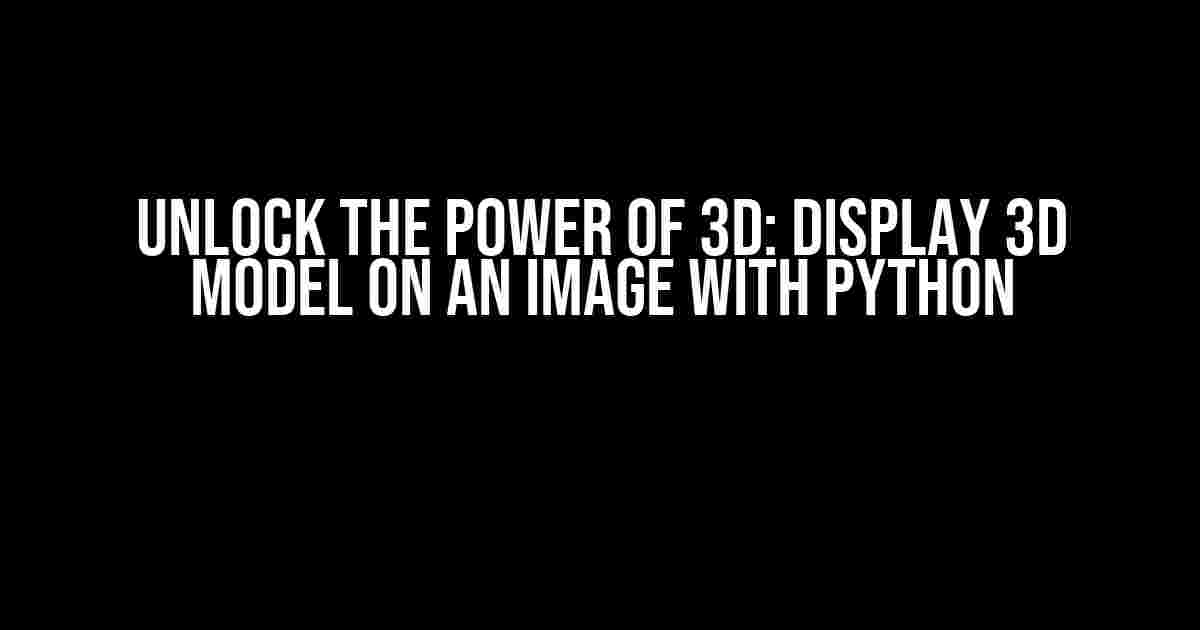Are you tired of plain 2D images? Do you want to take your visualizations to the next level? Look no further! In this article, we’ll explore the fascinating world of 3D modeling and show you how to display a 3D model on an image using Python. Buckle up, and let’s dive into the world of augmented reality!
What You’ll Need
To follow along, you’ll need:
- Python 3.x installed on your machine
- A 3D model in OBJ or STL format (we’ll use a sample model for this tutorial)
- An image on which you want to display the 3D model
- Python libraries: OpenCV, PyOpenGL, and PyOpenGL-accelerate (we’ll cover installation later)
Understanding the Concept
Before we dive into the code, let’s quickly understand the concept behind displaying a 3D model on an image. We’ll use a technique called texture mapping, which involves projecting a 2D image (our background image) onto a 3D object (our model). This creates the illusion of the 3D model being part of the original image.
Texture Mapping in a Nutshell
Here’s a simplified explanation of texture mapping:
- The 3D model is loaded and prepared for rendering.
- The background image is loaded and converted into a texture.
- The texture is applied to the 3D model, effectively “wrapping” the image around the model.
- The resulting 3D model with the applied texture is rendered on top of the original background image.
Setting Up Python Libraries
Before we start coding, we need to install the required Python libraries. Open your terminal or command prompt and run the following commands:
pip install opencv-python pip install PyOpenGL PyOpenGL-accelerate
Loading the 3D Model and Image
Create a new Python file and add the following code:
“`python
import cv2
import OpenGL.GL as gl
import OpenGL.GLU as glu
import numpy as np
# Load the 3D model
model_file = ‘model.obj’ # Replace with your 3D model file
model_vertices, model_faces = [], []
with open(model_file, ‘r’) as f:
for line in f:
if line.startswith(‘v ‘):
vertex = list(map(float, line.split()[1:]))
model_vertices.append(vertex)
elif line.startswith(‘f ‘):
face = list(map(int, line.split()[1:]))
model_faces.append(face)
# Load the background image
image_file = ‘image.jpg’ # Replace with your background image file
image = cv2.imread(image_file)
“`
Preparing the 3D Model for Rendering
We need to prepare the 3D model for rendering by setting up the vertex buffer object (VBO) and vertex array object (VAO):
“`python
# Create a VBO and VAO for the 3D model
vbo = gl.glGenBuffers(1)
vao = gl.glGenVertexArrays(1)
# Bind the VAO and VBO
gl.glBindVertexArray(vao)
gl.glBindBuffer(gl.GL_ARRAY_BUFFER, vbo)
# Copy the 3D model data into the VBO
gl.glBufferData(gl.GL_ARRAY_BUFFER, np.array(model_vertices, np.float32).nbytes, np.array(model_vertices, np.float32), gl.GL_STATIC_DRAW)
# Specify the vertex attributes
gl.glVertexAttribPointer(0, 3, gl.GL_FLOAT, gl.GL_FALSE, 0, None)
gl.glEnableVertexAttribArray(0)
“`
Applying the Texture
We’ll load the background image and convert it into a texture:
“`python
# Load the background image as a texture
texture_id = gl.glGenTextures(1)
gl.glBindTexture(gl.GL_TEXTURE_2D, texture_id)
gl.glTexImage2D(gl.GL_TEXTURE_2D, 0, gl.GL_RGBA, image.shape[1], image.shape[0], 0, gl.GL_BGR, gl.GL_UNSIGNED_BYTE, image)
gl.glGenerateMipmap(gl.GL_TEXTURE_2D)
gl.glTexParameterf(gl.GL_TEXTURE_2D, gl.GL_TEXTURE_MIN_FILTER, gl.GL_LINEAR_MIPMAP_LINEAR)
gl.glTexParameterf(gl.GL_TEXTURE_2D, gl.GL_TEXTURE_MAG_FILTER, gl.GL_LINEAR)
“`
Rendering the 3D Model
Now, we’ll render the 3D model with the applied texture:
“`python
# Render the 3D model
gl.glClear(gl.GL_COLOR_BUFFER_BIT | gl.GL_DEPTH_BUFFER_BIT)
gl.glMatrixMode(gl.GL_PROJECTION)
gl.glLoadIdentity()
glu.gluPerspective(45, image.shape[1] / image.shape[0], 0.1, 100)
gl.glMatrixMode(gl.GL_MODELVIEW)
gl.glLoadIdentity()
gl.glTranslatef(0, 0, -5) # Translate the model 5 units away from the camera
gl.glBindTexture(gl.GL_TEXTURE_2D, texture_id)
gl.glDrawArrays(gl.GL_TRIANGLES, 0, len(model_vertices) // 3)
“`
Displaying the Result
Finally, we’ll display the rendered image using OpenCV:
“`python
# Read the rendered frame from the framebuffer
frame_buffer_object = gl.glGenFramebuffers(1)
gl.glBindFramebuffer(gl.GL_FRAMEBUFFER, frame_buffer_object)
gl.glReadBuffer(gl.GL_BACK)
rendered_image = gl.glReadPixels(0, 0, image.shape[1], image.shape[0], gl.GL_BGR, gl.GL_UNSIGNED_BYTE)
# Convert the rendered image to OpenCV format
rendered_image = cv2.flip(rendered_image, 0)
cv2.imshow(‘3D Model on Image’, rendered_image)
cv2.waitKey(0)
cv2.destroyAllWindows()
“`
Putting it All Together
Here’s the complete code:
import cv2
import OpenGL.GL as gl
import OpenGL.GLU as glu
import numpy as np# Load the 3D model
model_file = 'model.obj' # Replace with your 3D model file
model_vertices, model_faces = [], []
with open(model_file, 'r') as f:
for line in f:
if line.startswith('v '):
vertex = list(map(float, line.split()[1:]))
model_vertices.append(vertex)
elif line.startswith('f '):
face = list(map(int, line.split()[1:]))
model_faces.append(face)# Load the background image
image_file = 'image.jpg' # Replace with your background image file
image = cv2.imread(image_file)# Create a VBO and VAO for the 3D model
vbo = gl.glGenBuffers(1)
vao = gl.glGenVertexArrays(1)# Bind the VAO and VBO
gl.glBindVertexArray(vao)
gl.glBindBuffer(gl.GL_ARRAY_BUFFER, vbo)# Copy the 3D model data into the VBO
gl.glBufferData(gl.GL_ARRAY_BUFFER, np.array(model_vertices, np.float32).nbytes, np.array(model_vertices, np.float32), gl.GL_STATIC_DRAW)# Specify the vertex attributes
gl.glVertexAttribPointer(0, 3, gl.GL_FLOAT, gl.GL_FALSE, 0, None)
gl.glEnableVertexAttribArray(0)# Load the background image as a texture
texture_id = gl.glGenTextures(1)
gl.glBindTexture(gl.GL_TEXTURE_2D, texture_id)
gl.glTexImage2D(gl.GL_TEXTURE_2D, 0, gl.GL_RGBA, image.shape[1], image.shape[0], 0, gl.GL_BGR, gl.GL_UNSIGNED_BYTE, image)
gl.glGenerateMipmap(gl.GL_TEXTURE_2D)
gl.glTexParameterf(gl.GL_TEXTURE_2D, gl.GL_TEXTURE_MIN_FILTER, gl.GL_LINEAR_MIPMAP_LINEAR)
gl.glTexParameterf(gl.GL_TEXTURE_2D, gl.GL_TEXTURE_MAG_FILTER, gl.GL_LINEAR)# Render the 3D model
gl.glClear(gl.GL_COLOR_BUFFER_BIT | gl.GL_DEPTH_BUFFER_BIT)
gl.glMatrixMode(gl.GL_PROJECTION)
gl.glLoadIdentity()
glu.gluPerspective(45, image.shape[1] / image.shape[0], 0.1, 100)
gl.glMatrixMode(gl.GL_MODELVIEW)
gl.glLoadIdentity()
gl.glTranslatef(0, 0, -5) # Translate the model 5 units away from the camera
gl.glBindTexture(gl.GL_TEXTURE_2D, texture_id)
gl.glDrawArrays(gl.GL_TRIANGLES, 0, len(model_vertices) // 3)# Read the rendered frame from the framebuffer
frame_buffer_object = gl.glGenFramebuffers(1)
gl.glBindFramebuffer(gl.GL_FRAMEBUFFER, frame_buffer_object)
gl.glReadBuffer(gl.GL_BACK)
rendered_image = gl.glReadPixels(0, 0, image.shape[1], image.shape[0], gl.GL_BGR, gl.GL_UNSIGNED_BYTE)# Convert the rendered image to OpenCV format
renderedHere are 5 questions and answers about "Display 3D model on an image with python" with a creative voice and tone:Frequently Asked Question
Get answers to the most frequently asked questions about displaying 3D models on images using Python!
Q1: What is the best Python library to display 3D models on images?
The best Python library to display 3D models on images is PyOpenGL, which is a Python binding to the OpenGL API. It allows you to create 3D graphics and overlay them on 2D images. Other popular libraries include Three.py and Matplotlib.
Q2: How do I load a 3D model in Python for display on an image?
You can load a 3D model in Python using libraries such as PyOpenGL, Three.py, or PyAssimp. These libraries provide functions to read 3D model files in various formats, such as OBJ, STL, andPLY. You can then use these libraries to display the 3D model on an image.
Q3: Can I display a 3D model on an image in real-time using Python?
Yes, you can display a 3D model on an image in real-time using Python. This requires using a combination of libraries such as OpenCV for image processing, PyOpenGL for 3D graphics, and a GUI library such as PyQt or Tkinter. You can create a GUI application that updates the 3D model and image in real-time.
Q4: How do I ensure that the 3D model is properly aligned with the image?
To ensure that the 3D model is properly aligned with the image, you need to perform image registration, which involves finding the transformation that aligns the 3D model with the image. You can use libraries such as OpenCV to perform image registration, and then apply the transformation to the 3D model.
Q5: Can I use Python to display 3D models on images in a web application?
Yes, you can use Python to display 3D models on images in a web application. You can use libraries such as Flask or Django to create a web application, and then use JavaScript libraries such as Three.js to display the 3D model in the browser. You can also use Python to generate the 3D model and image, and then send it to the browser for display.


